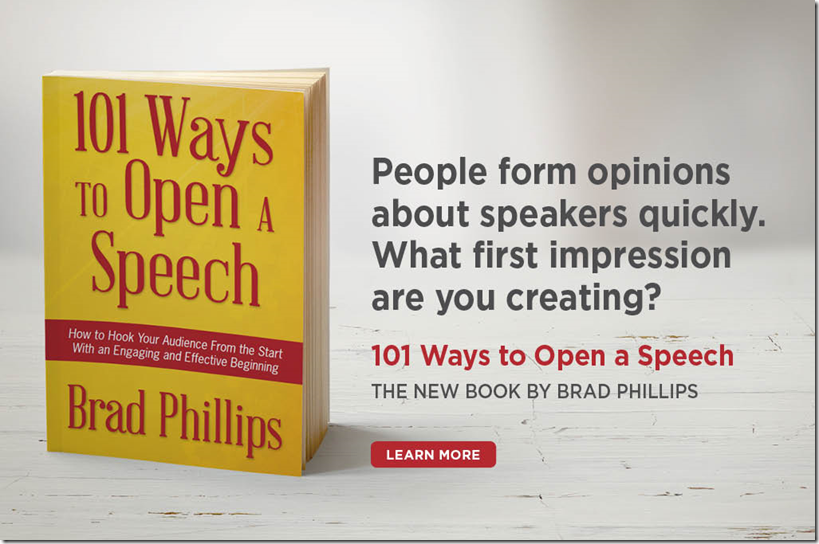Your ABSO: Audience-Focused Bright Shiny Object
In the last two posts, you learned how to create your presentation’s headline and analyze your audience. This post, the final one in this series, will help you connect your headline to your audience.
Now that you’ve diagnosed your audience, you have a better sense of where they are now, what their concerns or challenges are, and what points you might need to address during your talk to persuade them to adopt a new behavior or way of thinking.
The audience is so fundamental to your speaking success that we should put it front and center. Let’s take your bright shiny object (BSO), which is about your goals, one step further by modifying it to make sure it meets the audience where they are and turning it into an ABSO: An audience-focused bright shiny object.
To turn your BSO into an ABSO, consider how much change your audience is likely to accept. Ask yourself how large the gap between you and them is—and how much you can reasonably shrink it in a single talk. While you might want them to take a giant step with you, your audience diagnosis should illuminate whether a more modest goal would lead to a more successful result. For example, if you’re speaking to a community group that opposes your company’s proposal for a new shopping mall, a more realistic aim might be to soften their resistance by highlighting a few unexpected benefits rather than asking them to sign a petition in support of it.
Sometimes, your BSO won’t need to change at all. If you know many of the attendees, understand what drives them, and are confident that they’ll agree with your bright shiny object, your BSO may already be sufficiently audience focused. (You might still spend a few minutes diagnosing the audience to confirm that your assumptions about their perspectives and current level of knowledge are correct.)
But for other talks, such as when you’re speaking to strangers or an unfamiliar group—or are speaking to a familiar group about a new topic—your audience diagnosis may reveal a sizeable gap between you and them that requires a more meaningful BSO-to-ABSO adjustment.
These three questions will help confirm that your goals are appropriate:
- What are their thoughts or behaviors now?
- What do you want their thoughts or behaviors to be after hearing you speak?
- Is that realistic?
If your answer to the third question is no, reconcile the first two until you’re able to answer the third affirmatively.
Once you deem your goal realistic, you can turn your BSO into an ABSO by placing your audience onto a spectrum that indicates “now” and “after.” Most talks can be plotted on one of three spectrums; your goal for the talk, along with the results from your audience diagnosis, will help you decide which one to use. Some of these overlap—and for some talks, you might plot your talk on two or all three of these spectrums:
- Opposed to Supportive: This spectrum is best for persuasive talks intended to shift support in your direction.
- Inaction to Action: This spectrum is ideal for groups that are not taking the concrete action steps you would like them to.
- Unaware to Aware: This spectrum is ideal for groups that lack awareness or deep knowledge of an issue.
As an example, let’s say your BSO is:
“This new shopping mall will create local jobs, provide a safe community gathering space, and bring in much-needed retail options.”
If you’re speaking to a group that supports the new mall, your main goal might be to ask them to arrange a meeting with their local city council member to ask for their vote in support of the project. You would use the “Inaction to Action” spectrum to plot where they are now and where you might reasonably move them. Because they’re generally supportive of the project, you can probably persuade them to move straight to your end goal by taking an action step.
INACTION <——-now———————————after> ACTION
Based on where you’ve plotted your “now” and “after,” your ABSO might be:
“This new shopping mall would create local jobs, provide a safe community gathering space, and bring in much-needed retail options; to make it a reality, we’re asking each of you to meet with your local city council member this month to ask for their vote.”

But let’s say your audience diagnosis revealed that the group is opposed to the mall. During your research, you discovered that their primary concerns are increased traffic congestion, lowered home property values, and whether a shopping mall would alter the character of their neighborhood.
You might conclude that requesting an action step would be counterproductive—but that diminishing their vocal opposition to the project would help ease the path for reluctant city council members to approve it. In this case, use the “Opposed to Supportive” spectrum, placing them closer to the opposed side before you speak but aiming to move them to a position of neutrality by the end.
OPPOSED <—now————after——————–> SUPPORTIVE
For this group, your ABSO might be:
“This new shopping mall would help improve the character of our neighborhood by creating a safe gathering space for our children, boosting our home values (nearby retail is associated with a stronger real estate market), and creating new traffic patterns that will actually reduce the congestion that already exists today.”
In both cases, your main goal for the talk remains the same: you want to be able to move forward with your company’s proposed new shopping mall. What did change, however, is how you talk about your proposal and what you ask from each audience.
Here’s a final summary of the approach I recommended in this series for drafting an effective message:
- Develop your bright shiny object (BSO)
- Diagnose your audience
- Modify your BSO into an audience-focused bright shiny object (ABSO) based on what you learned about your audience (this post).




